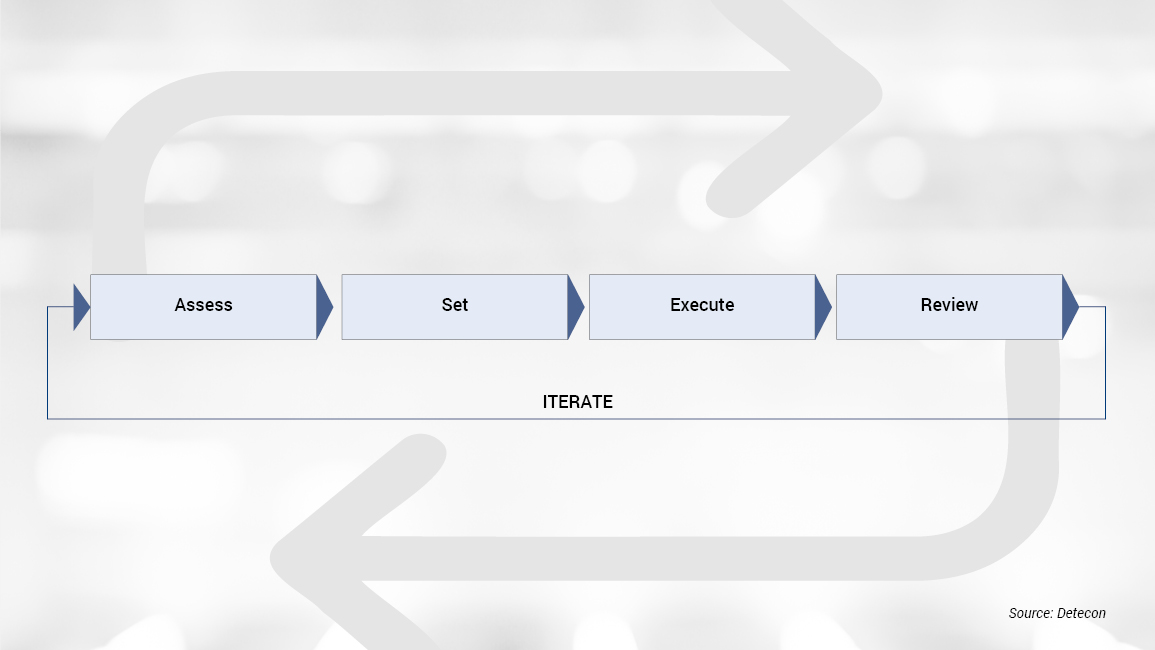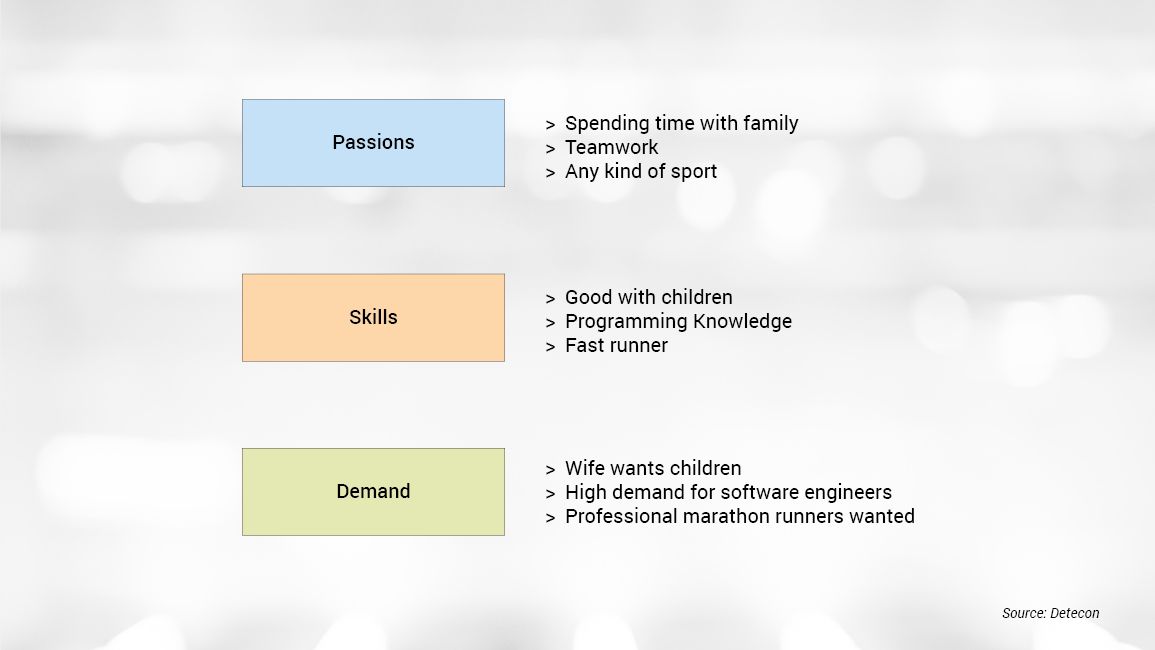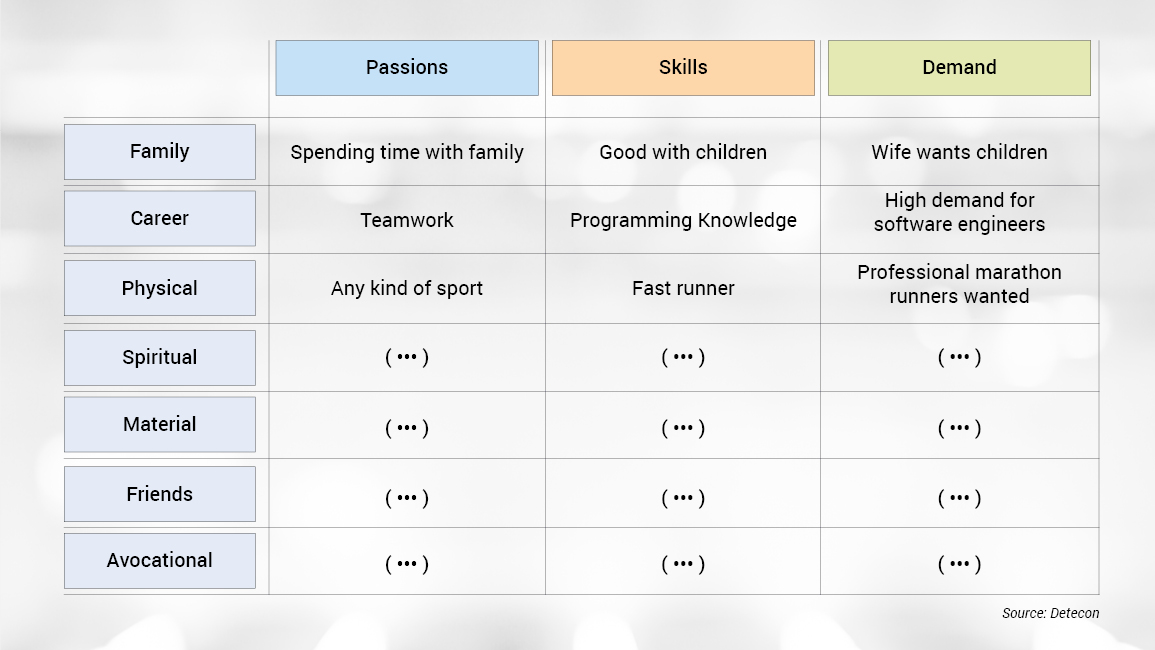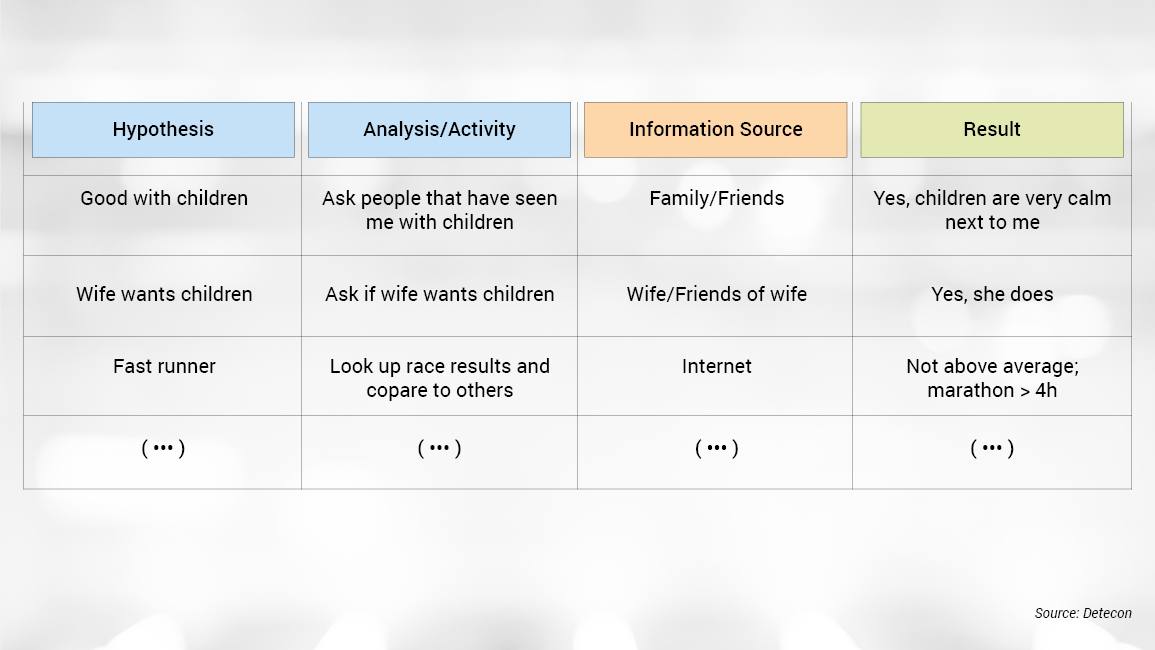A man walks into a job interview. Brand-new suit, polished curriculum, iron confidence. Today is his day: he knows it, and the interviewer is about to know it. Question one: nailed it. Question two: rocked it. Question three: the interviewer’s jaw drops to the floor at such a demonstration of wisdom. Handshake. They will call back. “Hey, just one more question”. Tension builds up. “Where do you see yourself in five years?”. Confidence crashes. If he does not know what he is going to do tomorrow, how can he know what he will be doing in five years? He never considered the importance of that question. He was just so busy before. In fact, taking a mental trip to his knowledge sources, he never came across the perfect answer during his university years or his previous jobs. And now, so much was dependent on it.
Unlike many other problems and questions, “where do you see yourself in five years?” goes beyond what you can find in the books. The basis for this question being so problematic is that it takes a lot of brainpower to be answered. But why is that even relevant? Who has the time for that? And how can someone find the answer to such a complex question efficiently and effectively if they were not taught how to do that? In this article, I will give an answer to the questions above and elaborate on why it is also important for organizations.
Why is that even relevant?
To provide an answer to the question, it is crucial to understand what the objective of this question is. No one expects you to be able to describe precisely what you will be doing in 1,826 days. Interviewers usually want to understand more about your vision and priorities and how the position you are applying for would fit into your grand plan. Additionally, visions are a way to make you think about what really is essential to you, also aside from job interviews.
Typically, a vision is a term used primarily in the corporate world. However, I believe it is equally vital for individuals to have a vision of their future and where they want to be in life. Because without a vision, you have no idea what you are or should be doing. You are just stumbling along, adhering to what others tell you is best for you.
Defining a compelling vision is inspiring. It has an apparent motivational effect on you and the people around you. It creates energy and enthusiasm, it increases commitment, and it fosters change. This encouraging aspect is particularly crucial in difficult or stressful times. Having a clear vision will produce persistence and remind you why you started. Especially now, with a current health crisis due to COVID-19 in front of our doors and a looming economic crisis on the horizon, it is even more important to have something to hold on to that inspires you and gives you the energy to keep going.
Additionally, having a vision provides a sense of purpose and direction. It gives clarity over what is essential and what you should focus on. Your vision will help you define your short- and long-term goals and will guide the decisions you make along the way. Therefore, the answer to the question “where do you see yourself in five years?”is your North Star on the horizon that acts as your navigation system. It helps you guide through times of stormy waters as well as during times of growth and excitement without losing track of what is imperative to you.
Who has time for that?
People dislike a lot of things. For example, some hate waking up early. Others are not keen on taking the garbage out. Some are uncomfortable with confrontation. However, one thing I realized that most people commonly dislike is self-reflection.
As every millennial that does not have an answer to a question, I resorted to Google and looked up why people are so hesitant to deeply reflect about themselves. Aside from the detailed psychological and biological explanations, I found an intriguing point of view on Quora that summarized the critical points for me:
- Self-reflection makes us feel vulnerable.
- Self-reflection makes us doubt that we might be doing wrong.
- Self-reflection is a fight with ourselves.
The dilemma here is that in order to answer the question of “where you see yourself in five years”,it is imperative to be self-reflective and to take the time to think about what you really want.
As people are uncomfortable doing that, they come up with the most popular excuse in history: I do not have time for that! If you have ever worked in any organization, you will know that this is the most widespread justification for not wanting to pick up work and do what has to be done. People would rather stay busy with being busy than focus on things that are critical to them and their organization.
Aside from the usual solutions to improve that (e.g., time management, prioritization, etc.), history is right now serving us with a very unique (yet cruel) solution: Coronavirus.
Now, for the first time ever, millions of people have that one indispensable resource at hand, the one that was never available before in years: time. Due to the impact of shelter-in-place guidelines, social distancing, short working hours, and, unfortunately, job loss, people are locked in at home with hours of available time at their disposal. And they have two choices of how they can spend it:
- Either they start reflecting on what is important to them and what they want in life,
- or they give in to the temptation of overloading themselves with news, Netflix, and YouTube, and start going in autopilot until everything is over or until they can go back to their daily grind of being busy with being busy.
For me, personally, this choice was pretty simple. I started reflecting on what is really important to me, where my priorities are, and where I see myself in five years.
How do I do it?
To find a way to answer this question, it is essential to take a more in-depth look into how a general goal achievement works. Achieving your goals or delivering any kind of project with an objective is usually based on a four-step iterative approach (or a slightly adjusted version depending on the framework you apply), as depicted in Figure 1: Assess, Set, Execute, and Review.

To answer the question “where do you see yourself in five years?”, the focus must essentially be on the first two phases. Let’s dive into them:
Assess (yourself)
The analysis of oneself can be done in many ways. You can start by only listing what you are (and are not) good at. You can look at your past failures and success factors to identify what works for you. Despite this being a good starting point, it lacks the structure to be comparable over time. The evaluation of oneself should be executed based on a framework. This helps to create comparability over time and sets a baseline for later reviews. Of course, you can now start creating a new framework for yourself, and it might even be a viable option. However, I recommend leveraging existing knowledge on how to approach something like this. I personally started basing my self-analysis on three core criteria as defined by Stanford professor Tina Seeling: passions, skills and demand.
- Passions stand for what excites and energizes you. It shows what your heart burns for.
- Skills stand for your strengths and capabilities. It summarizes what you can do.
- Demand stands for what the market needs. It highlights where somebody is in need of what you are good at.
The input for each criterion has to be initially based on your self-assessment. It must show a complete picture based on who you currently are and what you think you are capable of. In this step, it is essential to not fall into the trap to believe that just because you are passionate about something, you are automatically good at it. You must try to be as objective as you can.
Remember that man who walked into a job interview? Let us call him by his name: Joe. Figure 2 shows an example list of his passions, what he thinks he is skilled in and what he believes the market demand for his skills is.

As this list is mixing between the private and professional space, we do not have a clear and comparable picture. Therefore, we can detail even further to be more specific. This can be done by identifying the seven core playing fields of life: family, career, physical, spiritual, material, friends, and avocational.

Figure 3 illustrates how this further detailing looks like for Joe. So far, the listed points are nothing more than hypotheses based on a self-assessment. To make it more reliable for our vision setting later and to make it more comparable, it is essential to validate the hypotheses about Joe’s skills and the anticipated demand, meaning that someone or something must prove what you think of yourself. For this validation, Joe can apply roughly the Problem-Solving Design Plan approach suggested by Ken Watanabe. Such validation can be done through external benchmarks, past data, feedback from friends/colleagues or any other source suitable to provide input.
Joe must take special care not to succumb to the fallacy of overestimating his skills in comparison to peers. Just because he thinks he is good at something, it doesn’t mean that he is really good at it in comparison to his peers.

The outcomes in Figure 4 show that Joe is actually not as good of a runner as he thought. However, the hypotheses “good with children” and “wife wants children” were confirmed. This must be done for all the other hypotheses too in order to create a complete and validated picture of Joe.
Set (the vision)
Based on the initial assessment, Joe is now able to answer the question “where do you see yourself in five years?”. The hard work has been done by means of analyzing himself and reflecting upon his skills, passions, and the demand. Now he has to formulate his personal vision and priorities. As you might have guessed already, an ideal vision is placed between the intersection of your skills, passions, and demand. It is something (1) that you are passionate about, (2) for which there is a market demand and (3) that you have the skills for.
Joe can have a vision for each of the seven playing fields of his life. For each dimension, he has to ask himself the following: Who do I want to become in this part of my life? How much do I want to engage in this dimension? Given that I have limited energy, resources and time, how important is this compared to the other playing fields?
While thinking about an answer to these questions, it is paramount to realize two points: First, each playing field presents unique challenges. It is critical to split them apart so that, instead of facing an overwhelming whole, Joe can address distinct issues independently. Second, his evaluation will change over time. The idea is to develop an aspirational picture of himself for the future as a guide to decide where he spends his limited energy, resources, and time. His personal vision will support him when he is about to lose his balance and lose sight of what is essential.
If we go back now and try to answer the original question together with Joe, the vision for the family playing field becomes evident:
Joe likes children + he is very good with children + his wife wants children = he wants to be a good father.
Furthermore, Joe needs to understand that he can only achieve three of his visions at the same time in the desired quality. This does not mean that Joe cannot achieve all his visions in his life -just not at the same time. He might pursue them sequentially but never more than three parallelly. This concept is known as "the rule of three". To explain this, Joe would have to think about life as a massive buffet of appealing platters of possibilities, but placing too much on his plate just leads to stomachache. Just like a real buffet, in life, Joe can do it all, only not at the same time. This concept is not new. In fact, the U.S. Marine Corps use this rule as a universal guide. Through years of trial and error, they have discovered that most people can only pursue three things at once. As a result, the whole military system is meant to reflect this. Limiting himself to three core priorities can feel frustrating. However, Joe can avoid the “tyranny of the or” (having to choose between this or that) and prevent burning out due to an overwhelming number of tasks.
A man walks into another job interview. Brand-new suit, polished curriculum, iron confidence. And a clear answer to where he sees himself in five years. Joe finally found clarity and motivation, is sure about what he wants in life, and can tell apart who and what can help him accomplish his goals. He knows that this is the right job for him because the company aligns with his career vision. However, how does a company know what they are looking for?
Relevance for organizations
A company interviews a man who walks into a job interview. Nah, just kidding, I will save you the analogy this time. Companies also must reflect on where they see themselves in five years, and to do so, they must follow the same path as our friend Joe.
Why is that even relevant?
The answer is straightforward: if it is relevant for individuals, it is relevant for organizations, since organizations are "an organized body of people with a particular purpose, especially a business, society, association, etc."
For instance, the job interview situation highlights the importance of having a clear vision for an organization. To hire the right people, organizations need to ask themselves “where they want to be in five years” because, depending on where they want to go, they will require people with specific skills and similar professional visions.
Additionally, in times of uncertainty, it is more important than ever for organizations to have a clear vision of what they are doing. This is not only relevant for investors and partners to ensure direction in times of uncertainty but, even more, for employees to inspire and motivate them and give them something to hold on to. It also is essential to understand which tasks to focus on and which ones to stop doing in times of crisis.
Who has time for that?
Organizations are currently focusing on extinguishing the fire. The primary focus is to stop the revenue leakage that is hitting them as well as ensuring business continuity in their operations (e.g., keeping supply chains up, ensuring continuous production, etc.).
However, organizations should ask themselves if they want to lead through the crisis… or merely manage the response.As mentioned in a recent HBR article by Eric J. McNulty and Leonard Marcus, “leading through a crisis requires taking the long view, as opposed to managing the present. You need to anticipate what comes next week, next month, and even next year to prepare the organization for the changes ahead”.
Therefore, as soon as the first wave of the Great Lockdown has passed, organizations should take the chance and start re-evaluating where their priorities are and what is essential for their survival and future growth.
How do I do it?
Analyzing organizations is, to a certain degree, very similar to the analysis of individuals. This analysis is, of course, more labor-intensive and cannot only be done with a quick 4x4 matrix. Nevertheless, the core principles stay the same.
The first step is to understand the core capabilities of the organization and what the hearts of the employees are burning for. Furthermore, the market demand for these capabilities has to be identified. These factors need to be analyzed in light of the core playing fields of an organization: customers, strategy, operations, technology, culture, and data.
Afterward, based on the initial assessment, the overall vision and strategic priorities can be set. These priorities will help organizations define their short- and long-term goals and guide their decisions along the way.
The article was originally published on 21.04.2020 here on LinkedIn.







